SECTION I MULTIPLE CHOICE
(Suggested writing time
25 minutes; value 25% of your mark)
Each question is followed by four possible answers
marked A, B, C and D. Select the best answer.
When you have decided on your choice, record your answer in
Section I of the answer booklet.

1. The man in the doorway is most anxious to protect
his
A identity
B language
C employment
D neighbourhood
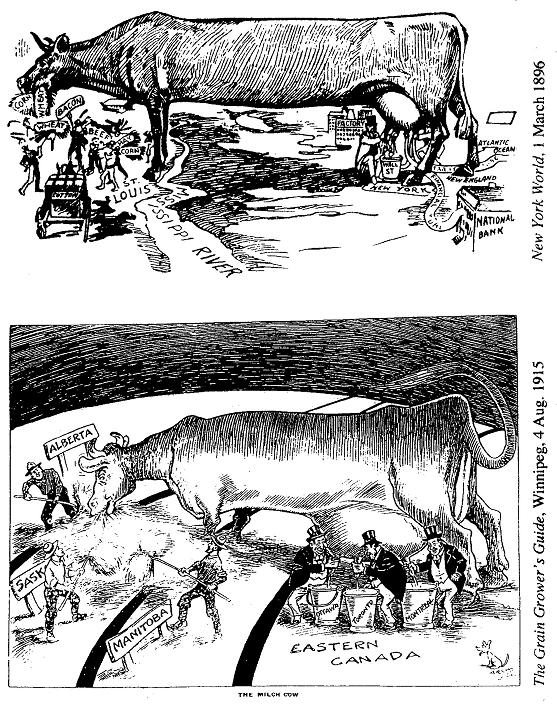
2. Which one of the following statements is not
supported by the cartoons? Both cartoonists
A use cows to symbolize
government
B are resentful of the large cities and business interests
in the east
C believe that the profits from natural resource
exploitation end up in the east
D believe that the “cow” works in the
best interest of both the east and the
west

3. The darkest area
should be dated
A 1841
B 1864
C 1867
D 1870
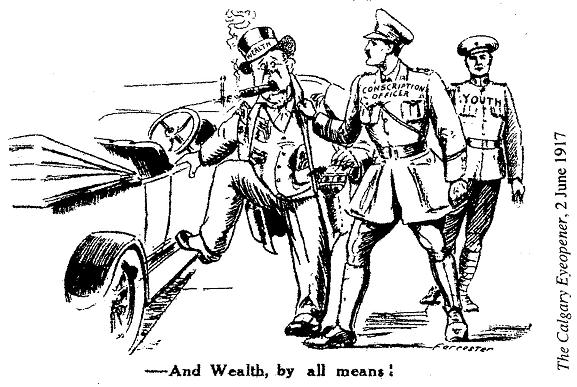
4. The officer would like the cigar smoking gentleman
to
A hire returning soldiers
B enlist in the armed forces
C
refrain from smoking in public
D contribute more money to the war effort

Thanks Samuel! Your heart is as big as your country
is broad. You have Canada’s heartfelt gratitude.
5. This cartoon deals with
A free trade
B
foreign aid
C disaster relief
D the US war effort
6. Arrange the following
events in chronological order (earliest to latest):
1 Louis Riel is
hanged
2 Sir John A. Macdonald dies
3 the capital of Canada is moved
to Ottawa
4 Saskatchewan enters Confederation
A 3, 1, 2, 4
B 1, 3,
2, 4
C 4, 1, 2, 3
D 2, 3, 1, 2

7. The “treasure
chest” in the title refers to the
A. Canadian Shield
B. Appalachian
Mountains
C. Hudson Bay Lowlands
D. St. Lawrence Lowlands
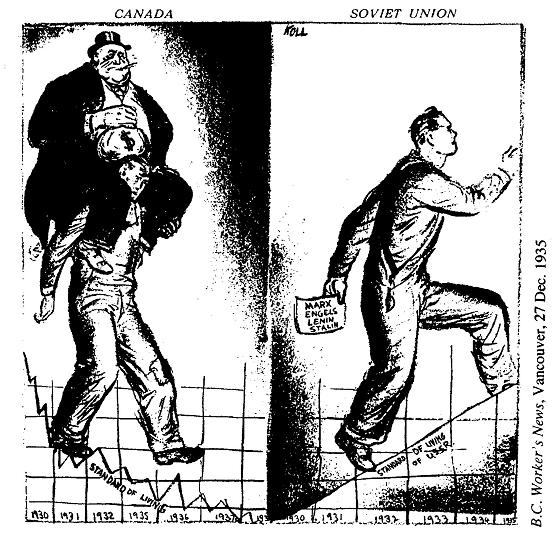
8. This cartoon reflects
the economic and political thinking of the
A Conservative party
B
Liberal party
C Co-operative Commonwealth Federation
D Communist party
9. “The Governor-General shall from time
to time, in the King’s name, by instrument under the Great Seal, summon
qualified persons to the Senate.”
Section 24 of the British North
America Act
In
1928 a major constitutional debate erupted when five Alberta women
challenged the interpretations of these words:
A Governor-General
B
in the King’s name
C Great Seal
D qualified persons
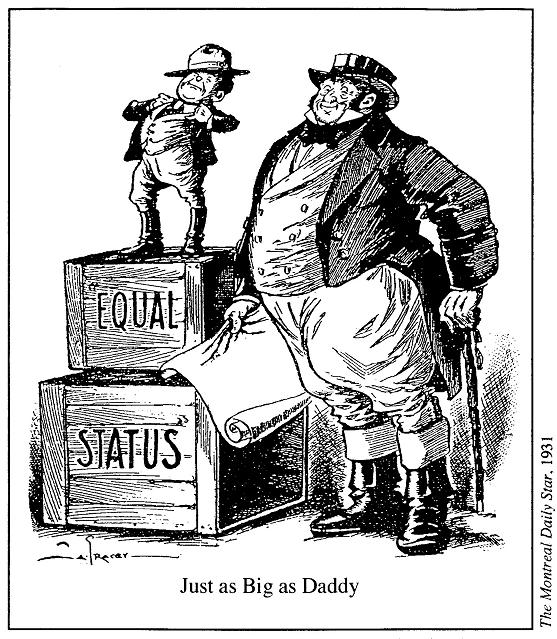
10. This cartoon was produced in
celebration of the
A Canadian Naval Act
B Statute of
Westminster
C British North America Act
D Charter of Rights
and Freedoms
Documents 1, 2, 3

11. These documents deal with the
conscription issue during the Second World War. The order in which they
occurred (from earliest to latest) is
A 1, 2, 3
B 3, 2, 1
C 2, 1,
3
D 2, 3, 1

12.
Taken together, these poll results indicate that
A. French Canadians
were more nationalistic than English Canadians
B. English Canadians
were more nationalistic than French Canadians
C. There was little
difference in the nationalistic position of English and French
Canadians
D. Canadians of “other stock” were more nationalistic than
either the English
or the French

13. The principle motive of the
man labelled “Labor” is
A ethnic identity
B racial equality
C
class solidarity
D gender equality
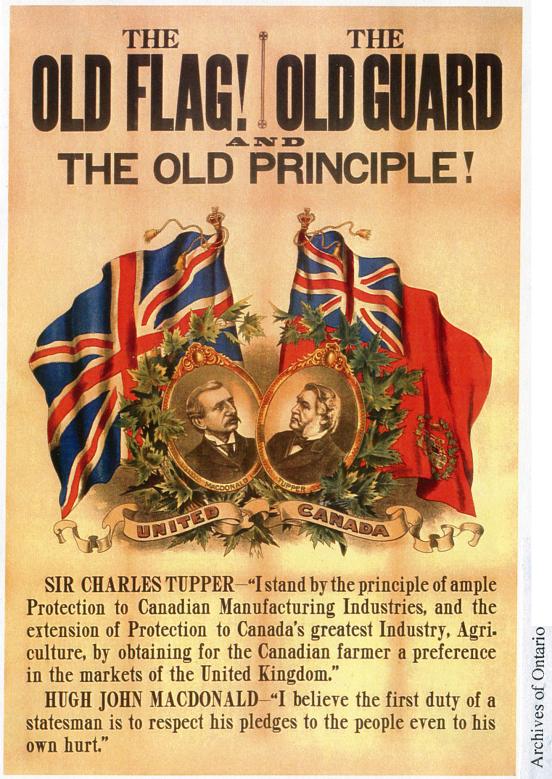
14. This poster
was produced during the election of 1896. Hugh Macdonald, the son of Sir
John A. Macdonald, was seeking election to parliament. The “old principle”
Tupper and Macdonald support was known as
A manifest destiny
B
commercial union
C the national policy
D unrestricted reciprocity

15. This
sheet music cover best illustrates the concept of
A nationalism
B
imperialism
C monarchism
D
internationalism

16. This magazine
cover was designed to
A promote enlistment
B encourage exercise
C
promote conscription
D. market children’s clothing

17. The most dramatic change
in Canada’s trade between 1881 and 1965 was the
A rise in trade from
other countries
B decline in trade with the United Kingdom
C rise in
trade with the Unites States of America
D rise and fall of trade
with the United
Kingdom

18. The
women depicted in these stamps made their mark in
A science
B
health
C politics
D business

19. This illustration of Canadian immigration was
likely produced in
A 1875
B 1915
C 1955
D 1995

20. The cartoon was likely published
during
A the interwar years
B the Second World War
C the Cold
War
D the post Cold War era

21. Oil was
eventually moved from Prudhoe Bay to the United States by means of
A
rail
B water
C pipeline
D pipeline and water
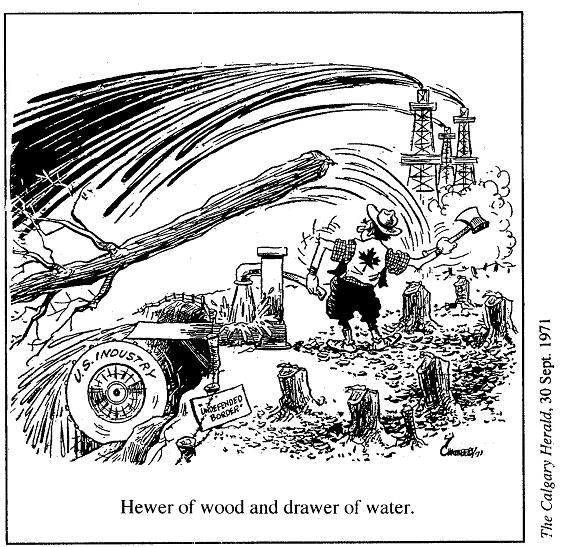
22. This cartoon is critical of Canadian
A
consumerism
B industrial policy
C clear-cut logging
D safety
regulations
23.
Which one of the following is a secondary source description of the
raising of the Maple Leaf flag on Parliament hill for the first time on
February 15, 1965?
A A photograph of Prime Minister Lester Pearson
raising the new Canadian flag
B An article describing the event written
by someone born in 1965
C A tape recording of a radio announcer
describing the flag raising ceremony
D Opposition leader John
Diefenbaker describing how he felt when the new flag was
raised

24. The accompanying photograph refers to a vote
on
A sovereignty
B prohibition
C conscription
D capital punishment
25. “We
are living on islands of our own in the Sea of Canada – Chinatown,
Greektown, Little Italy, Little India, Ste. Boniface, Westmount –
associating with each other largely through trade and commerce. But we
have nothing much in common. Canada is becoming a community of
communities.”
Andrew Cohen, The Unfinished Canadian, 2007.
The
author is questioning the concept known as
A bilingualism
B
regionalism
C nationalism
D multiculturalism
SECTION II SHORT ANSWER RESPONSE
QUESTION
(Suggested writing time 15 minutes; value 15% of your mark)
Study the two photographs and their captions. Write a short essay on the significance of French leader Charles de Gaulle’s visits to Ottawa in 1944 and Montreal in 1967.
Document A

France-Canada, Ottawa, August 1944. The
photograph was taken in Ottawa. It shows, from left to right, a
Canadian general, Free French leader Charles de Gaulle, Prime Minister
Mackenzie King, and Minister of Justice Louis St. Laurent. At the time de
Gaulle was the leader of the Free French Forces who opposed the occupation
of France by Nazi Germany and who were living
in exile in England.
Document B
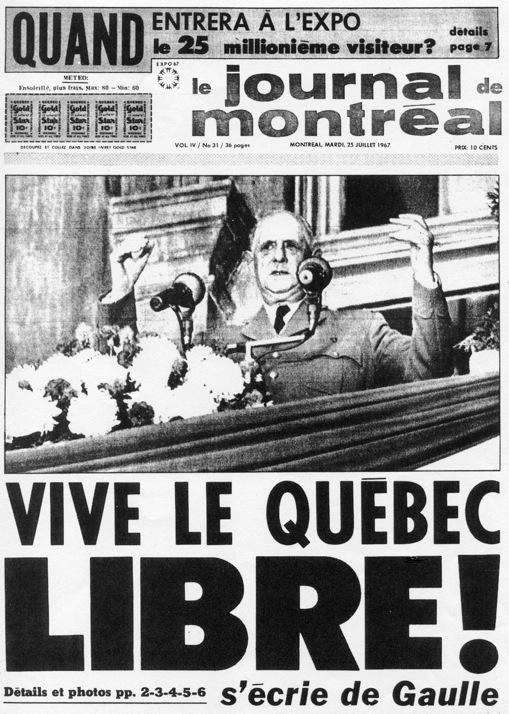
Journal de Montréal, July 1967. President
Charles de Gaulle of France was invited to visit Expo 67 during Canada’s
centennial celebrations. He landed in Quebec City. On his way to Ottawa he
visited Montreal and gave a speech in which
he shouted “Vive Le Québec Libre!”
SECTION
III ESSAY RESPONSE QUESTION
(Suggested writing time 80 minutes; value 60% of your
mark)
The
purpose of this section is to test your ability to analyze and interpret
historical documents. To complete this task successfully, consider the
following steps and suggested time allowances:
(1) Read the background
information and the instructions (5 minutes).
(2) Read and analyze
documents 1–10 (20 minutes).
(3) Decide on a thesis and prepare an
outline for your essay (10 min.).
(4) Write your essay in Section III
of the answer booklet (40 minutes).
(5) Proofread your essay (5
minutes).
Use
as many of the documents as possible.
Only the essay will be
marked.
Background Information
In 1954 Donald Gordon was president of the Canadian National Railway (CNR), an independent Crown corporation. In November he announced that a new CNR hotel would be built in Montreal. With the newly crowned queen’s approval he stated that it would be called the Queen Elizabeth Hotel. It would be owned by the CNR and operated by the American-owned Hilton hotel chain. The Queen Elizabeth Hotel opened in 1958.
Instructions
Write an essay explaining why you agree or disagree
with Donald Gordon’s decision to name the new hotel the Queen Elizabeth
Hotel. Be sure to indicate where you found the evidence to support your
thesis (Documents 1, 2, 3 etc. – cite as
D1, D2, D3 etc.).
Document 1
Ethnic Composition of Montreal Island, in Percentages, 1871-1961
| Year | French | British | Others |
| 1871 | 60.3 | 38.1 | 1.6 |
| 1901 | 63.9 | 31.6 | 4.5 |
| 1921 | 60.7 | 27.3 | 12.0 |
| 1941 | 62.6 | 24.5 | 12.9 |
| 1961 | 63.8 | 22.2 | 14.0 |
| 1951 | 62.0 | 18.1 | 19.9 |
Marc Levine,
The Reconquest of Montreal, p. 10
Document 2
This is a French province and Montreal is an
overwhelmingly French city, to which visitors flock from across the
country and mainly from below the border, to be in an atmosphere that is
different from the rest of North America...We have great respect for our
gracious Queen but has the time not come for us to be a little more
expressive of our being Canadians? Surely we have already paid more than
sufficient respect to the Royal family in this City in the naming of
hotels and hospitals.
James P. Nelson,
“Were So Hoping For French Name,” letter to the editor, The Montreal Daily
Star, 9 Nov. 1954.
Document 3
Our Anglo-Canadian fellow countrymen don't understand our
aspirations and constantly seek to literally impose their language and
traditions upon us. This attitude is particularly obvious in Montreal. The
English-speaking capitalists of this city strive to give it an English
character by all means imaginable, including the use of countless huge
neon signs and billboards worded in their language. They have succeeded
rather well to hide the French character of the metropolis...the Canadian
National is the property of all Canadians, including some 4,500,000 French
Canadians.
Claude Desrosiers, “This
Hotel Name,” Newsletter published by La Société Saint-Jean Baptiste de
Montreal, December 1954. [tr.]
Document 4
The
arguments for [the name] Chateau Maisonneuve are so compelling that it
seems incredible they did not prevail in the beginning... Maisonneuve, who
founded Montreal more than three hundred years ago, repeatedly risked his
life to save the little settlement from extinction and is properly
remembered as one of our nation’s greatest men. Nothing could be less
appropriate than that the Queen’s name be allowed to become the centre of
a controversy about a hotel... The controversy can be ended with dignity
in only one way––if the Queen’s advisors ask her to withdraw assent to the
use of her name.
Editorial, “Donald Gordon and the Chateau Blunder,”
Maclean’s Magazine, Toronto, 14 May 1955
Document 5
The League for National Action took the lead...with a campaign to have
the name changed [from Queen Elizabeth to Maisonneuve]. The League immediately received the
spontaneous approval of a vast array of organizations: La Société Saint-Jean Baptiste de Montreal, Association of
French Canadian Youth, Council of French living in America, [500 municipalities] etc.
A public petition was launched. In a few weeks...it bore
250,000 signatures.
Pierre Laporte, “Is the fight for Chateau Maisonneuve
lost?”, L'Action Nationale, March 1956, pp. 648-51 [tr.]
Document 6
In the most important
centre of downtown Montreal...stands a splendid statue as a constant
memorial to the founder of Montreal –– Paul Chomedey de
Maisonneuve. But a certain group of citizens, including Mayor Drapeau, consider this
not enough, and wish to have the name [changed]... Do they not know
that two of the finest hotels in Canada, the Chateau Laurier hotel in the national capital
of Canada bears the name of Canada’s greatest French Canadian statesman, Sir
Wilfrid Laurier, and Quebec City takes pride in the great
Chateau Frontenac?
Fair Minded Citizen, “Maisonneuve Already Adequately
Honored,” The Montreal Star, letter to the editor, 23 May 1956
Document 7
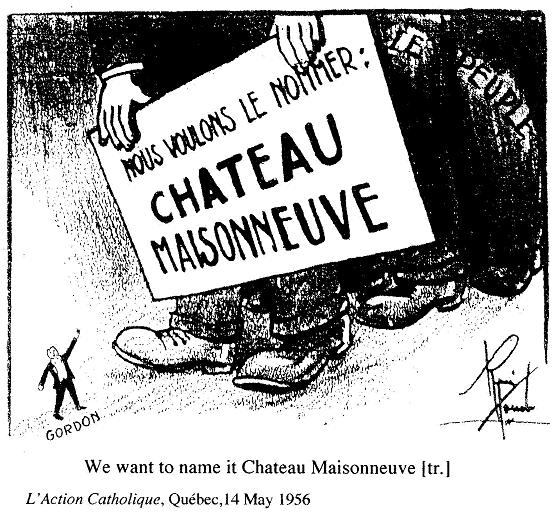
Document 8
The decision of the board of directors...in naming the hotel
“The Queen Elizabeth,” was based generally on a belief that it, of all
names, would symbolize the unity between the two language groups in our
country... We have in the course of constructing the hotel...emphasized...
Quebec history, in the decor and the choice of furnishings in the rooms of
the hotel...[and in the naming of rooms]...the agitation which has
developed represents a very small minority group, organized for the
purpose of keeping this type of grievance alive...the great majority of
the reasonable people of the province of Quebec find the name quite
acceptable...
Donald Gordon,
Testimony, Sessional Committee on Railways and Shipping, House of Commons,
18 March 1957
Document 9
Hotel's name protested 
“Students stomp on a loose straw effigy of Donald
Gordon, CNR president, in a demonstration yesterday afternoon in front of
the McGill St. head office of the railroad. The students were protesting
the name of the new Queen Elizabeth Hotel, which they want to be called
Chateau Maisonneuve.”
Photograph, “Hotel’s Name Protested,”
The Gazette, Montreal, 28 March 1957
Document 10
The Chateau Maisonneuve affair”... was
the wake-up call for French Canadian nationalism, fairly dormant since the
post-war
years... From this moment more and more French Canadians realized the
contempt of English Canadians toward them and decided that Canada could no
longer be their country.
François-Albert Angers [founder of the
League for National Action, see doc. 5], “The affair of the Chateau
Maisonneuve,” L'Action Nationale, Montreal, 1978, vol. 68 (7), pp. 579-586
[tr.]
Answer Sheet